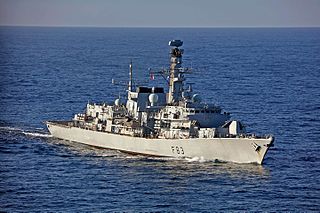
HMS St Albans is a Type 23 frigate of the Royal Navy. She is the sixth ship to bear the name and is the sixteenth and final ship in the 'Duke' class of frigates. She is based in Devonport, Plymouth.

The siege of Malta in World War II was a military campaign in the Mediterranean Theatre. From June 1940 to November 1942, the fight for the control of the strategically important island of the British Crown Colony of Malta pitted the air and naval forces of Fascist Italy and Nazi Germany against the Royal Air Force (RAF) and the Royal Navy.
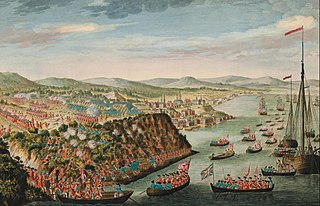
Amphibious warfare is a type of offensive military operation that today uses naval ships to project ground and air power onto a hostile or potentially hostile shore at a designated landing beach. Through history the operations were conducted using ship's boats as the primary method of delivering troops to shore. Since the Gallipoli Campaign, specialised watercraft were increasingly designed for landing troops, material and vehicles, including by landing craft and for insertion of commandos, by fast patrol boats, zodiacs and from mini-submersibles.

The X class was a World War II midget submarine class built for the Royal Navy during 1943–44. It was substantially larger than the original Chariot manned torpedo.

The Zeebrugge Raid on 23 April 1918, was an attempt by the Royal Navy to block the Belgian port of Bruges-Zeebrugge. The British intended to sink obsolete ships in the canal entrance, to prevent German vessels from leaving port. The port was used by the Imperial German Navy as a base for U-boats and light shipping, which were a threat to Allied control of the English Channel and southern North Sea. Several attempts to close the Flanders ports by bombardment failed and Operation Hush, a 1917 plan to advance up the coast, proved abortive. As ship losses to U-boats increased, finding a way to close the ports became urgent and the Admiralty became more willing to consider a raid.

Operation Source was a series of attacks to neutralise the heavy German warships – Tirpitz, Scharnhorst and Lützow – based in northern Norway, using X-class midget submarines.

HMS Malcolm was one of eight Admiralty-type destroyer leaders built for the Royal Navy during World War I. She was the first of only two Royal Navy ships to carry the name Malcolm, although HMS Valkyrie was originally planned to bear the name. She was one of two Admiralty-type leaders to miss the First World War but saw service in, and survived, the Second World War. Her pennant number was changed from D19 to I19 in May 1940. She was broken up in 1945.
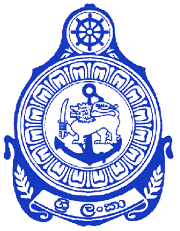
The Sri Lanka Navy (SLN) is the naval arm of the Sri Lanka Armed Forces and is classed as the country's most vital defence force due to its island geography and is responsible for the maritime defense of the Sri Lankan nation and its interests. The role of the Sri Lanka Navy is to conduct operations at sea for the defence of the nation and its interests and conduct prompt and sustainable combat operations at sea in accordance with the national policies.

Admiral of the Fleet Sir Michael Patrick Pollock, was a senior officer in the Royal Navy who rose to become First Sea Lord and Chief of the Naval Staff in the early 1970s. In the Second World War, he was an officer on ships tasked with protecting convoys in the Atlantic and the Mediterranean, and was gunnery officer on the cruiser HMS Norfolk when she fought the German battleship Scharnhorst during the Battle of North Cape. He later commanded the aircraft carrier HMS Ark Royal, and hosted Ian Smith on HMS Tiger. In retirement, he held the position of King of Arms of the Order of the Bath and Gloucester King of Arms, with responsibility for heraldry in Wales.

A depot ship is an auxiliary ship used as a mobile or fixed base for submarines, destroyers, minesweepers, fast attack craft, landing craft, or other small ships with similarly limited space for maintenance equipment and crew dining, berthing and relaxation. Depot ships may be identified as tenders in American English. Depot ships may be specifically designed for their purpose or be converted from another purpose.
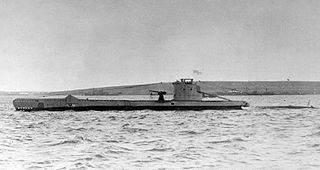
HMS Urge was a British U-class submarine, of the second group of that class, built by Vickers Armstrong, Barrow-in-Furness. She was laid down on 30 October 1939, and was commissioned on 12 December 1940. From 1941–1942 she formed part of the 10th Submarine Flotilla based in Malta and is the only Royal Navy ship to have borne the name. Urge spent most of her career operating in the Mediterranean, where she damaged or sank a number of Italian warships and merchant vessels and took part in special operations. She was commanded by Lieutenant-Commander Edward Philip Tomkinson, DSO, RN. She was lost with all hands and a number of passengers on 27 April 1942 after striking a German mine off Malta.

Vice-Admiral Sir Arthur Richard Hezlet, nicknamed Baldy Hezlet, was a decorated Royal Navy submariner. He became the Royal Navy's youngest captain at the time – aged 36 – and its youngest admiral, aged 45. In retirement he became a military historian.

HMS Bonaventure was a submarine depot ship of the Royal Navy. She was initially built for civilian service with the Clan Line, but on the outbreak of the Second World War she was requisitioned by the Navy and after being launched, was converted for military service.
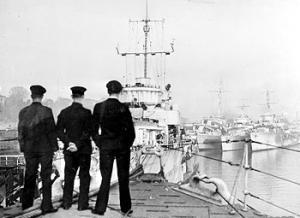
HMS Ferret was a shore establishment and naval base of the Royal Navy during the Second World War, located in Derry. It was given a ship's name as a stone frigate.

An amphibious warfare ship is an amphibious vehicle warship employed to land and support ground forces, such as marines, on enemy territory during an amphibious assault.

HMS Bicester(pennant number L34) was an escort destroyer of the Type II Hunt class. The Royal Navy ordered Bicester's construction three months after the outbreak of the Second World War. Hawthorn Leslie & Co. laid down her keel at their Tyne yard on 29 May 1940, as Admiralty Job Number J4210. The ship was named after a fox hunt in Oxfordshire.

The Eastern Fleet, later called the East Indies Fleet, was a fleet of the Royal Navy which existed between 1941 and 1952.
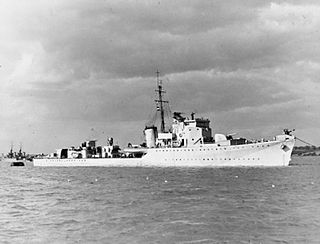
The second HMS Hambledon was a Hunt-class destroyer of the Royal Navy in commission from 1940 to 1945. She was a member of the first subgroup of the class, and saw service throughout World War II.
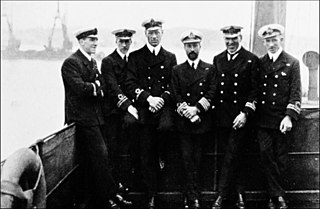
Captain Cedric Naylor was a Royal Navy officer of the First and Second World Wars. Naylor was a merchant seaman before joining the Royal Naval Reserve on the outbreak of the First World War. In November 1915 he was posted as first lieutenant to HMS Penshurst, a Q-ship, a warship disguised as a merchant vessel intended to fool German U-boats into surfacing so they could be sunk. Naylor received the Distinguished Service Cross for his part in the sinking of SM UB-19 on 30 November 1916 and a bar for further operations in February and March 1917. Naylor was granted temporary command of Penshurst after its captain was incapacitated in June and the next month damaged a submarine, for which he was awarded the Distinguished Service Order. Further distinguished service in the following months saw him receive a bar to the medal and a transfer to the Royal Navy. Naylor was hunting for SM U-110 on Christmas Eve 1917 and Penshurst was struck by a torpedo fired by the submarine. Despite suffering heavy damage Naylor remained onboard with two gun crews, hoping the U-boat would surface to finish off the ship. When U-110 surfaced it was hit twice and damaged before Penshurst sank. Naylor survived and was awarded a second bar to his DSO. He commanded the sloop Polyanthus for the remainder of the war.



















